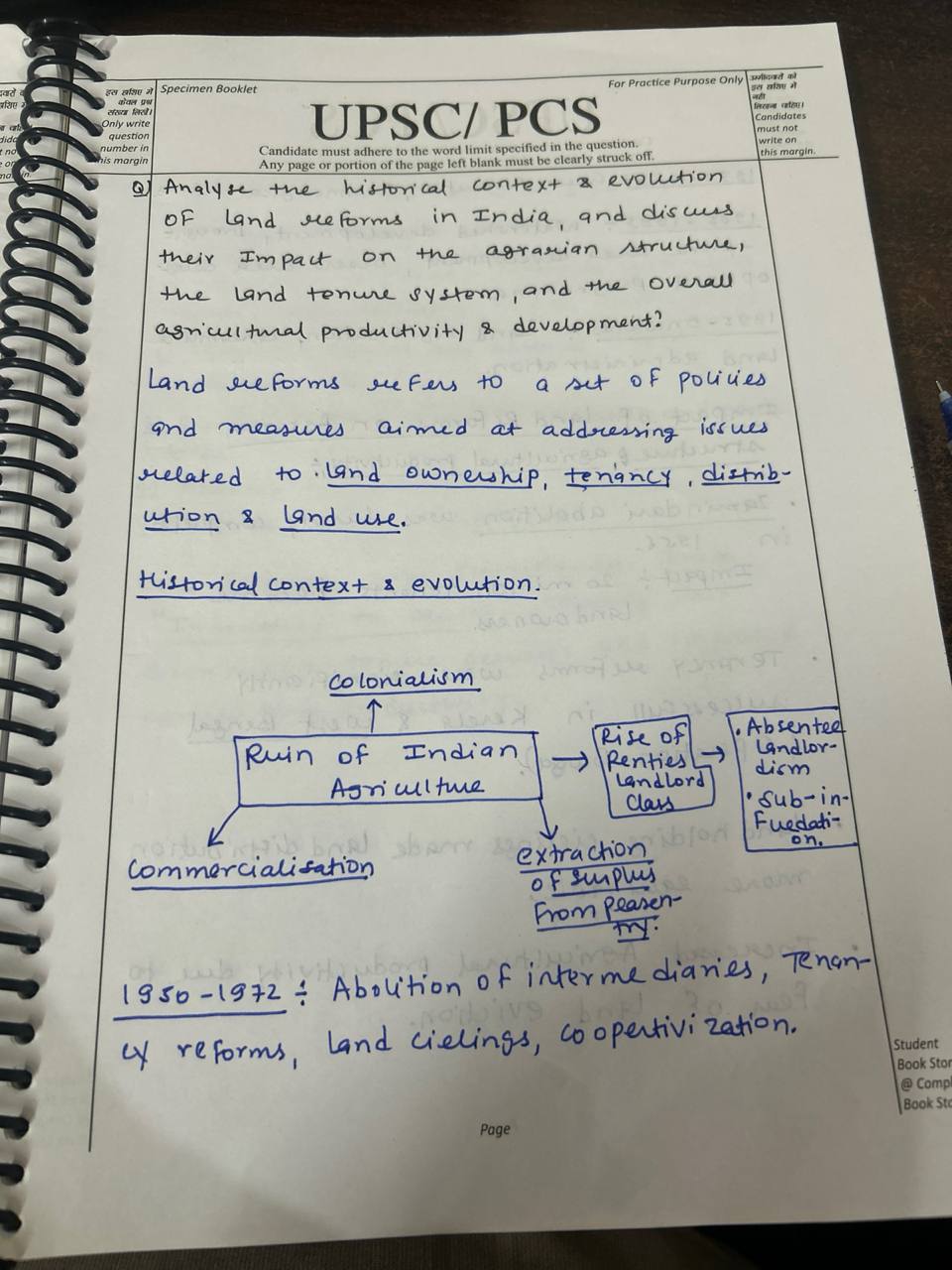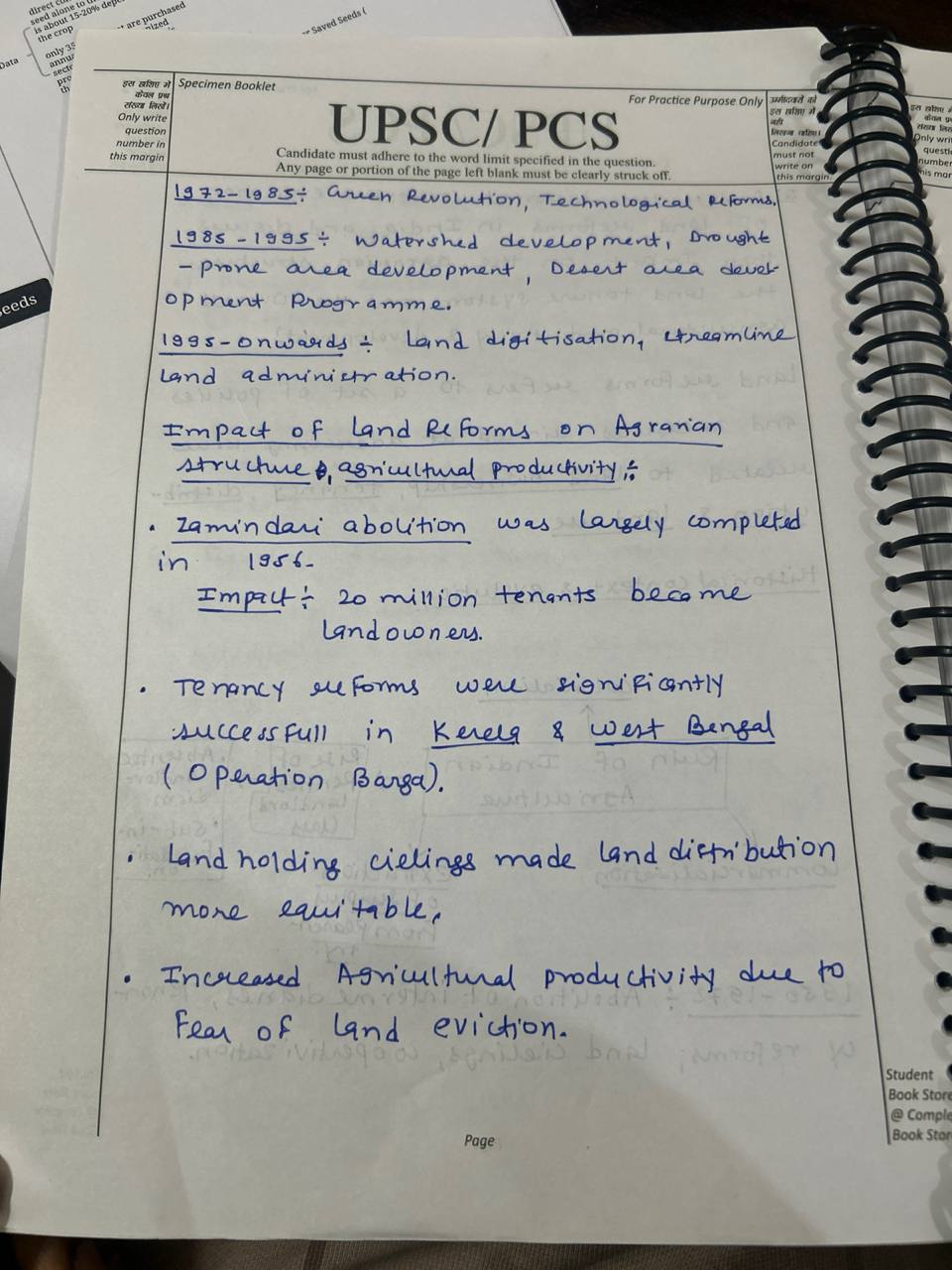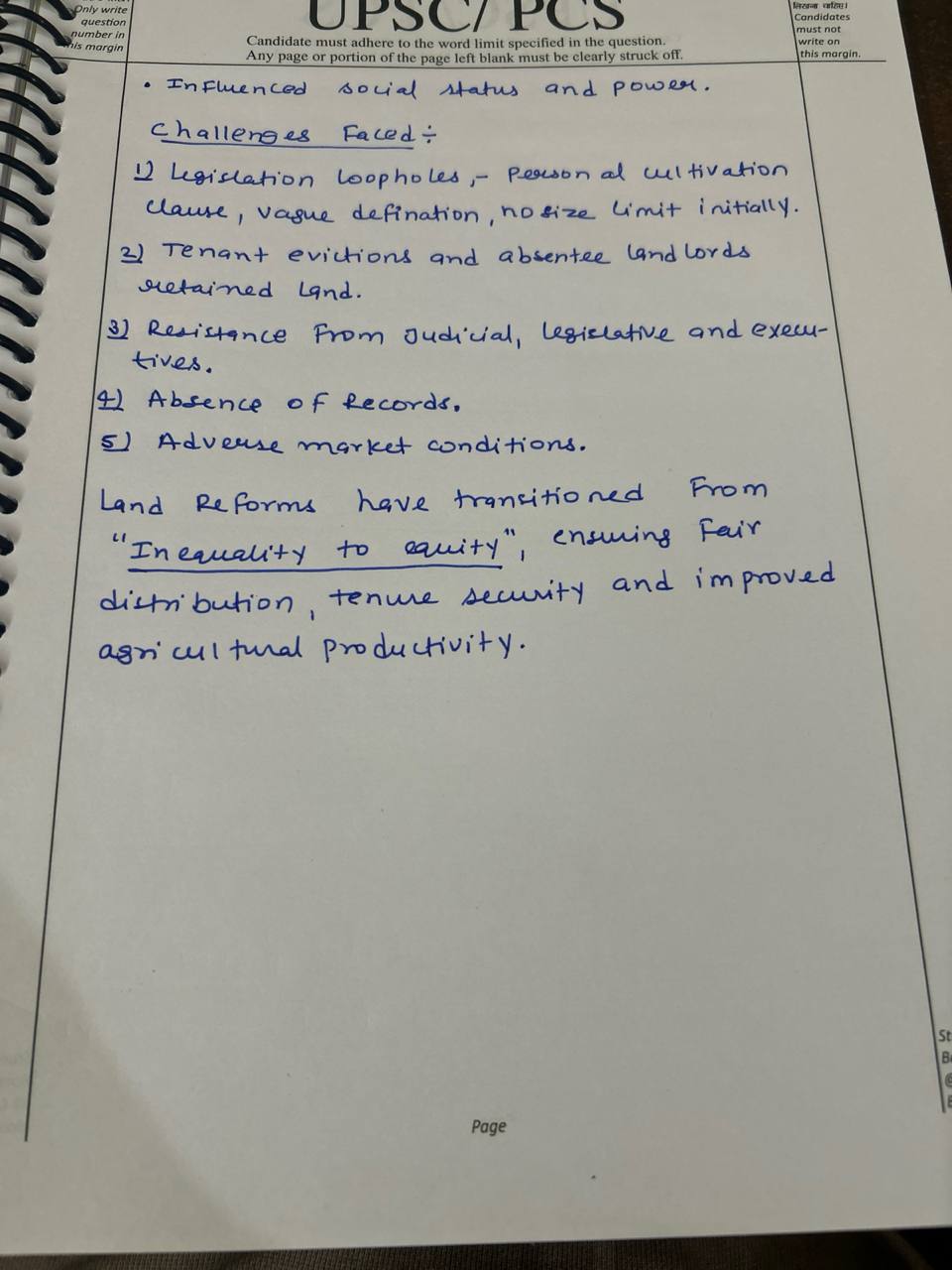Evaluate how land-use patterns and agrarian relations have been affected by the commercialization of agriculture, the growth of infrastructure, and urbanization. Talk about the policies and regulatory frameworks needed to protect the rights and interests of small and marginal farmers.
Challenges and Measures in the Implementation of Land Reforms Land reforms in India have been crucial in addressing issues related to land ownership, equity, and agricultural productivity. However, the implementation of these reforms has faced several challenges. This analysis highlights the key chaRead more
Challenges and Measures in the Implementation of Land Reforms
Land reforms in India have been crucial in addressing issues related to land ownership, equity, and agricultural productivity. However, the implementation of these reforms has faced several challenges. This analysis highlights the key challenges—political resistance, legal hurdles, administrative capacity constraints, and social and cultural barriers—and proposes measures to overcome them, with recent examples illustrating these issues.
1. Political Resistance
Challenges:
- Resistance from Powerful Landowners: Political resistance often comes from influential landowners and political entities who benefit from the status quo. For example, in states like Punjab and Haryana, land reforms faced resistance from entrenched political groups and influential landowners who lobbied against the redistribution of land.
- Lack of Political Will: Changes in political leadership can lead to inconsistent implementation of land reform policies. For instance, variations in commitment to land reform across different state governments have led to uneven progress.
Measures Required:
- Broad-Based Political Consensus: Building a broad-based political consensus on the importance of land reforms is essential. Engaging political leaders from all parties in dialogue can help in creating a unified approach.
- Public Awareness Campaigns: Educating the public and stakeholders about the benefits of land reforms can reduce resistance. Programs like the Pradhan Mantri Awas Yojana (PMAY) have shown the effectiveness of public engagement in policy implementation.
2. Legal Hurdles
Challenges:
- Complex Legal Framework: The legal framework for land reforms is often complex and fragmented, leading to delays and disputes. For example, the implementation of the Land Acquisition Act, 2013, faced legal challenges and delays due to its complex provisions and contentious amendments.
- Land Records and Title Disputes: Inaccurate or outdated land records lead to disputes and delays in the implementation of land reforms. States like Uttar Pradesh and Bihar have experienced significant issues with land record management, complicating land transfer processes.
Measures Required:
- Simplification of Legal Procedures: Streamlining and simplifying legal procedures related to land reforms can expedite implementation. Efforts to modernize land records and digitize land management systems, as seen in the Digital India Land Records Modernization Programme (DILRMP), can address these issues.
- Legal Reforms: Updating and consolidating land laws to reduce ambiguity and conflicts can enhance efficiency. The recent amendments to the Indian Forest Act and the introduction of the National Land Records Modernization Program (NLRMP) aim to address some of these issues.
3. Administrative Capacity Constraints
Challenges:
- Inadequate Infrastructure: Many states lack the administrative infrastructure and resources required to implement land reforms effectively. For example, the implementation of the ceiling-surplus land distribution has been hampered by inadequate administrative support in states like Odisha.
- Bureaucratic Inefficiencies: Bureaucratic inefficiencies and corruption can slow down the implementation process. Reports from various states, including Jharkhand and Madhya Pradesh, highlight issues of inefficiency and corruption in land administration.
Measures Required:
- Strengthening Administrative Capacity: Investing in administrative infrastructure and training for officials can enhance the effectiveness of land reform programs. The use of technology, such as Geographic Information Systems (GIS) for land mapping, can improve administrative efficiency.
- Decentralization: Empowering local bodies and decentralizing administrative functions can improve the implementation of land reforms. Initiatives like the Panchayati Raj Institutions (PRIs) can play a crucial role in local land administration and dispute resolution.
4. Social and Cultural Barriers
Challenges:
- Resistance from Traditional Structures: Social norms and traditional practices often resist land reforms, especially in rural areas. For instance, traditional village panchayats may resist changes in land ownership patterns, as seen in some regions of Tamil Nadu.
- Gender Inequality: Women often face barriers in land ownership and access, due to cultural and social biases. Despite legal provisions for women’s land rights, implementation remains inconsistent, as evidenced by low female land ownership rates in states like Rajasthan.
Measures Required:
- Community Engagement: Engaging with local communities and addressing their concerns can reduce resistance. Programs that involve community leaders and stakeholders in the planning and implementation stages can foster greater acceptance.
- Promoting Gender Equity: Implementing measures to promote gender equity in land ownership, such as the Sukanya Samriddhi Yojana and other gender-focused policies, can address social biases and improve land access for women.
Conclusion
The effective implementation of land reforms in India faces multiple challenges including political resistance, legal hurdles, administrative constraints, and social and cultural barriers. Overcoming these challenges requires a multifaceted approach involving political consensus, legal simplification, administrative strengthening, and community engagement. Recent initiatives such as the Digital India Land Records Modernization Programme and gender-focused land policies indicate progress, but continued efforts are necessary to address the remaining issues and achieve the full potential of land reforms.
See less



Impact of Commercialization, Infrastructure, and Urbanization on Land-Use and Agrarian Relations The transformation of the Indian agricultural sector has been shaped by the commercialization of agriculture, the expansion of infrastructure, and the process of urbanization. Let's assess the impact ofRead more
Impact of Commercialization, Infrastructure, and Urbanization on Land-Use and Agrarian Relations
The transformation of the Indian agricultural sector has been shaped by the commercialization of agriculture, the expansion of infrastructure, and the process of urbanization. Let’s assess the impact of these changes on land-use patterns and agrarian relations, and discuss the policy and regulatory frameworks needed to protect the rights and interests of small and marginal farmers.
1. Commercialization of Agriculture
2. Expansion of Infrastructure
3. Urbanization and Its Impacts
4. Policy and Regulatory Frameworks
Conclusion
See lessThe commercialization of agriculture, the expansion of infrastructure, and the process of urbanization have had significant impacts on land-use patterns and agrarian relations in India. While these transformations have contributed to economic growth, they have also led to the displacement of small and marginal farmers, the erosion of traditional agrarian systems, and the loss of agricultural land. Effective policy and regulatory frameworks, along with the strengthening of institutional capacity and the empowerment of local communities, are crucial to ensuring the protection of the rights and interests of small and marginal farmers in the face of these far-reaching changes.